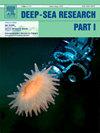克拉里昂-克利珀顿断裂带东部深海多金属结核区tanaidaceae(甲壳类:Peracarida)的多样性和分布
IF 2.1
3区 地球科学
Q2 OCEANOGRAPHY
Deep-Sea Research Part I-Oceanographic Research Papers
Pub Date : 2025-05-16
DOI:10.1016/j.dsr.2025.104521
引用次数: 0
摘要
在太平洋Clarion-Clipperton断裂带(CCFZ)的深海平原中,塔尼纲动物是一个重要的大型动物组成部分。从CCFZ的东端,特别是OMS(新加坡)和UK-I(英国)勘探区以及最近的一个特别环境利益区域(api -6),检查了大量的稀土材料。2013年至2020年进行的3次研究巡航中,主要使用箱盖、底栖雪橇和多重覆盖,在4016-4336 m深度的89个站点采集了约1800只个体。根据形态特征鉴定,共鉴定出12科98种和形态种,其中85%未描述。在CCFZ已有记录的35种tanaid中,只有7种在本研究中被重新发现。OMS和UK-I地区分别记录了85种和71种,与其他勘探地区报告的物种丰富度相比,这些高物种丰富度可能是由于更多的采样努力。尽管OMS和UK-I的地理位置接近,但只有59%的记录物种在这两个地区之间是共同的。在OMS和UK-I合并区域,南北站点在物种密度、物种丰富度和物种组成上存在差异。有趣的是,相对较远的api -6记录了11种,这些物种都存在于OMS和UK-I中。本研究未发现援助社区措施与非生物因素有任何关系。本研究的另一个重要结果是,在通常的300 μm网目的基础上增加250 μm网目,保留在筛子上的个体总数增加了25 - 32%,但物种总数没有增加。0 ~ 2 cm沉积物层的个体数量是2 ~ 5 cm沉积物层的1.4 ~ 3.0倍,是5 ~ 10 cm沉积物层的2.1 ~ 8.3倍。本文章由计算机程序翻译,如有差异,请以英文原文为准。
Diversity and distribution of Tanaidacea (Crustacea: Peracarida) in the abyssal polymetallic nodule fields of the eastern Clarion-Clipperton Fracture Zone
Tanaidaceans comprise a significant macrofaunal component of the abyssal plains in the Clarion-Clipperton Fracture Zone (CCFZ), Pacific Ocean. A large amount of tanaid material were examined from the eastern end of CCFZ, specifically the OMS (Singapore) and UK-I (United Kingdom) exploration areas and one of the nearest Area of Particular Environmental Interest APEI-6. Some 1800 individuals were collected from 89 stations at 4016–4336 m depth primarily using the box corer, epibenthic sled and multiple corer during three research cruises conducted between 2013 and 2020. Based on morphological characters, a total of 98 species and morphospecies belonging to 12 families were identified from these specimens, of which 85 % are undescribed. Only seven of the 35 described tanaid species previously recorded from CCFZ were rediscovered in this study. The OMS and UK-I areas recorded 85 and 71 species, respectively, and these high species richness as compared to values reported in other exploration areas could be due to greater sampling effort. Despite the close geographical proximity of OMS and UK-I, only 59 % of recorded species were common between the areas. Differences were observed in tanaid density, species richness and species composition between the northern and southern stations in the combined areas of OMS and UK-I. Interestingly, the relatively distant APEI-6 recorded 11 species, all of which were also present in OMS and UK-I. This study did not detect any relationship between tanaid community measures and abiotic factors. Another important outcome of this study is that the addition of the 250 μm mesh to the usual 300 μm mesh increased the total number of individuals retained on the sieves by 25–32 %, but not the total number of species. Even though the 0–2 cm sediment layer contained 1.4–3.0 times and 2.1–8.3 times more individuals than the 2–5 cm and 5–10 layers, respectively, no species was found exclusively at the top layer.
求助全文
通过发布文献求助,成功后即可免费获取论文全文。
去求助
来源期刊
CiteScore
4.60
自引率
4.20%
发文量
144
审稿时长
18.3 weeks
期刊介绍:
Deep-Sea Research Part I: Oceanographic Research Papers is devoted to the publication of the results of original scientific research, including theoretical work of evident oceanographic applicability; and the solution of instrumental or methodological problems with evidence of successful use. The journal is distinguished by its interdisciplinary nature and its breadth, covering the geological, physical, chemical and biological aspects of the ocean and its boundaries with the sea floor and the atmosphere. In addition to regular "Research Papers" and "Instruments and Methods" papers, briefer communications may be published as "Notes". Supplemental matter, such as extensive data tables or graphs and multimedia content, may be published as electronic appendices.

 求助内容:
求助内容: 应助结果提醒方式:
应助结果提醒方式:


